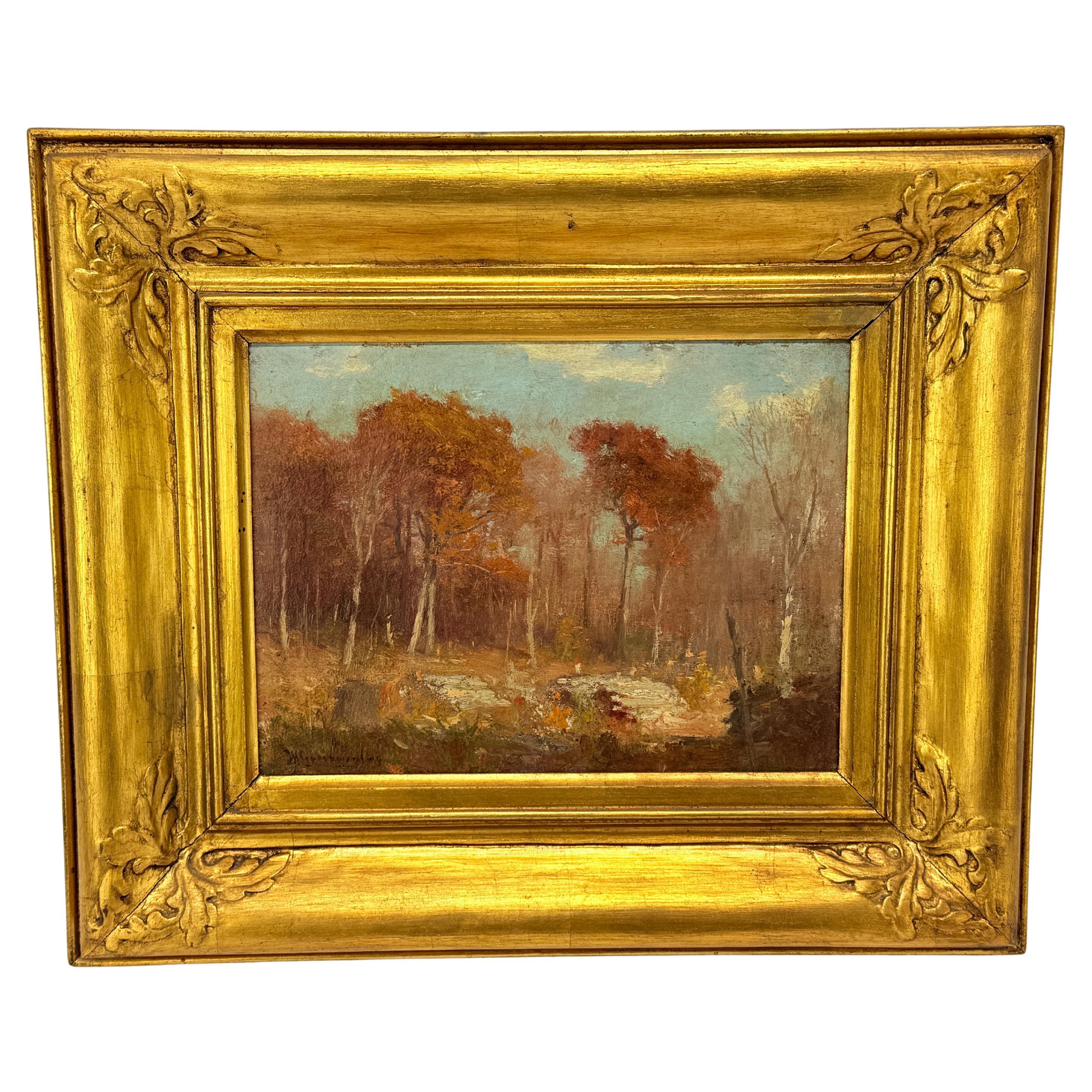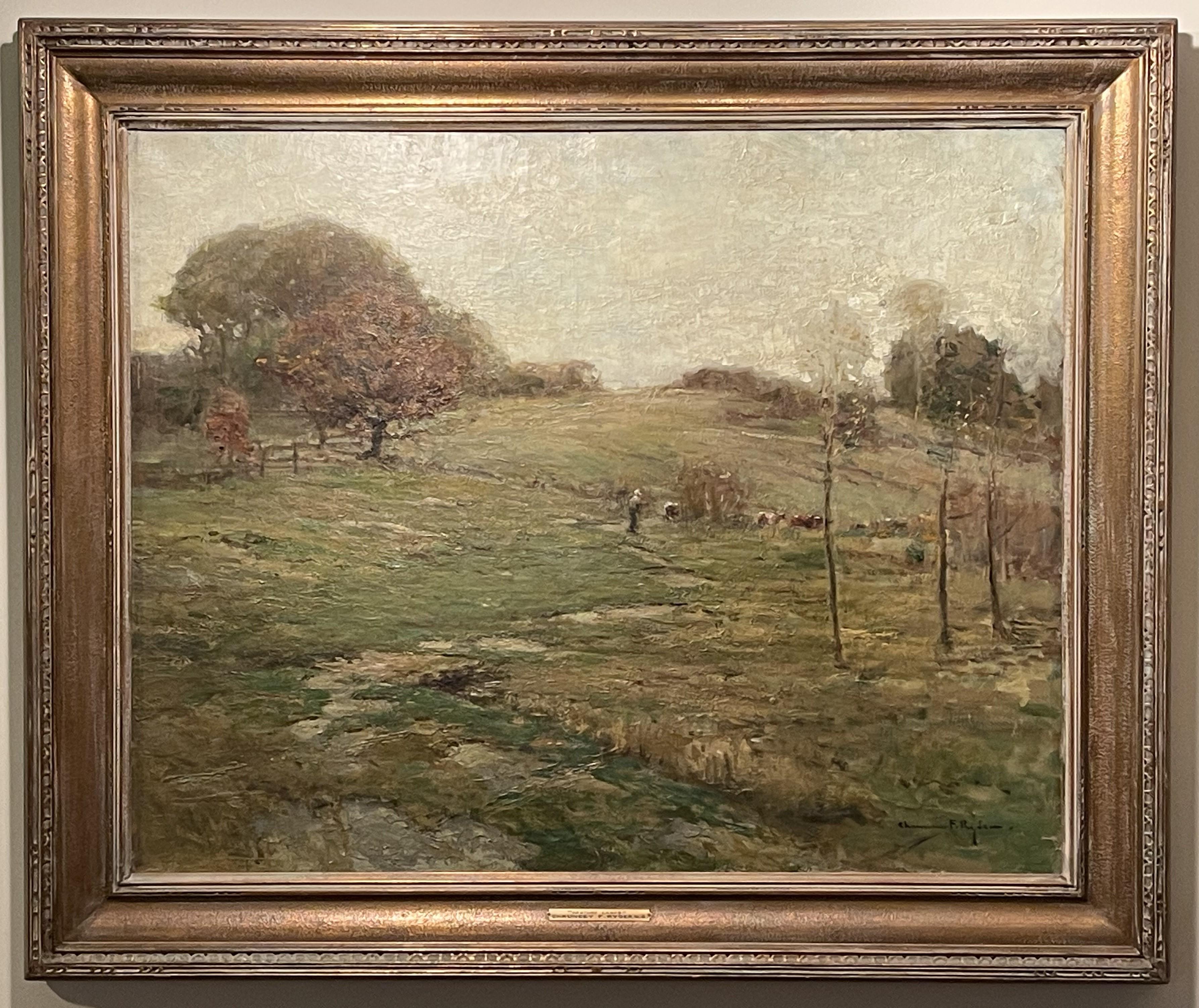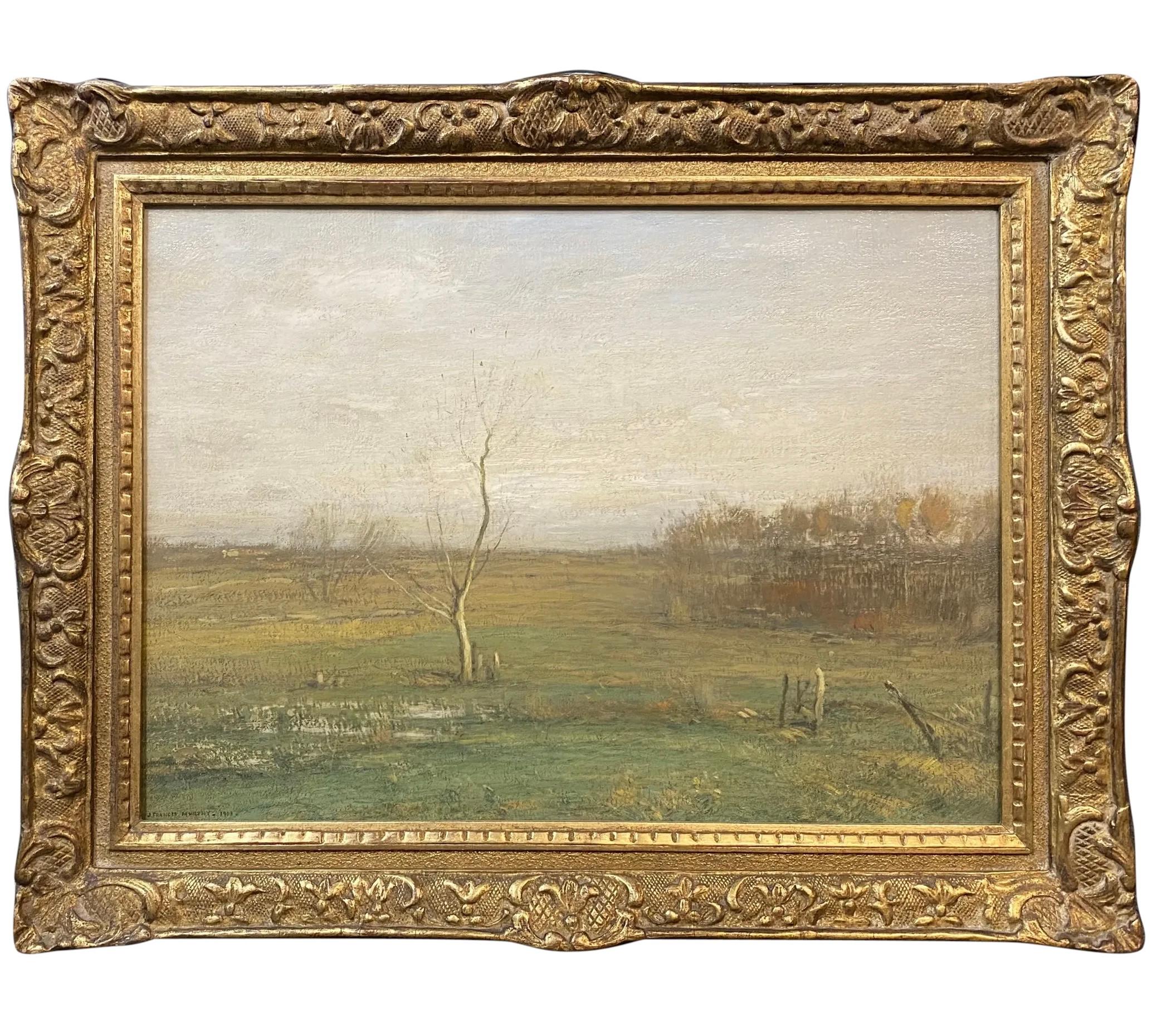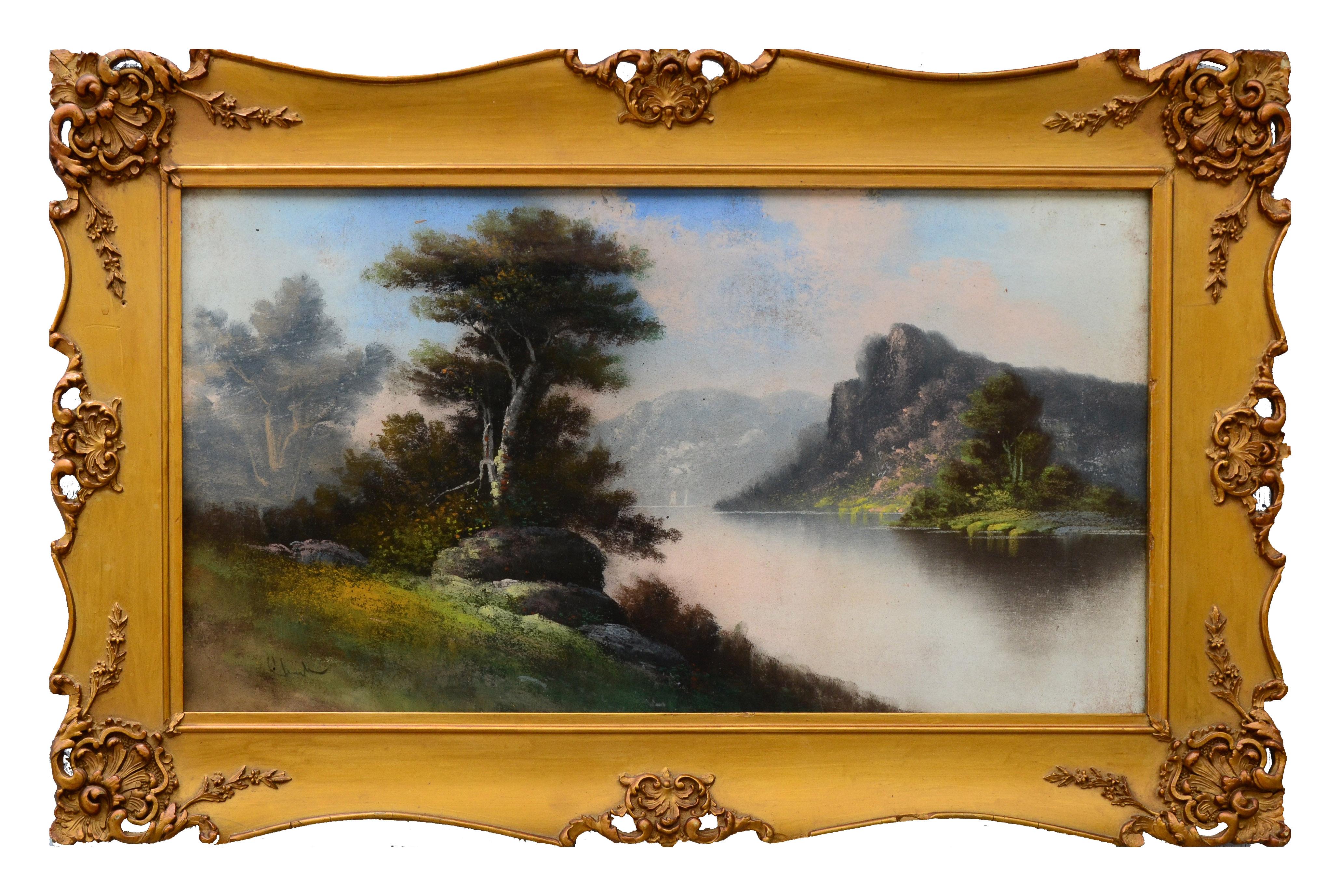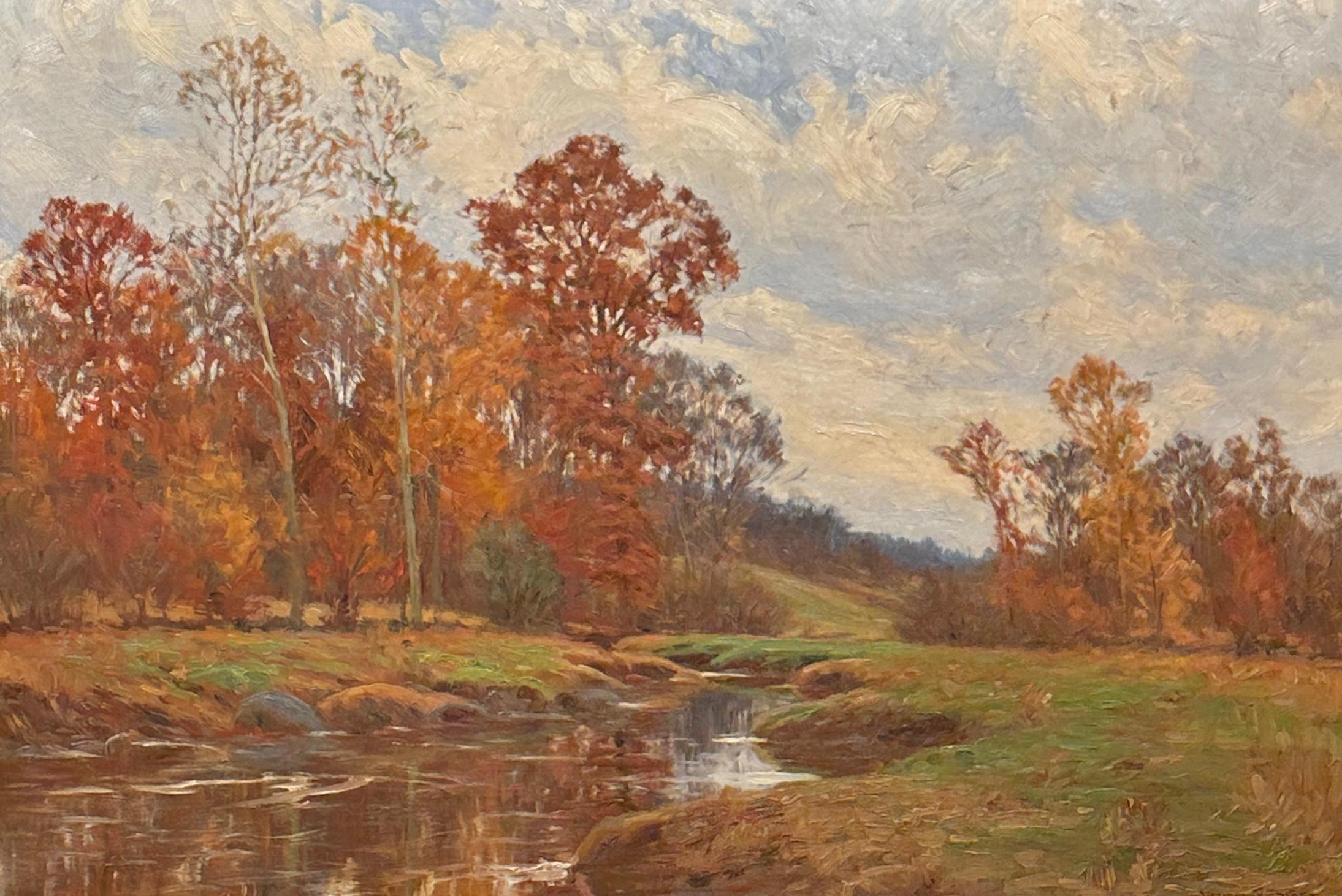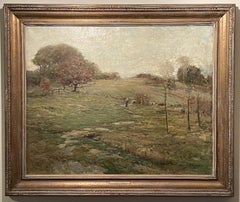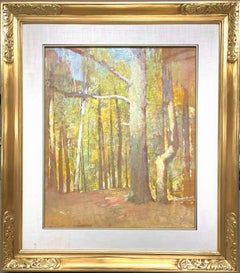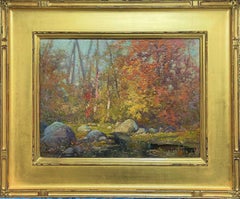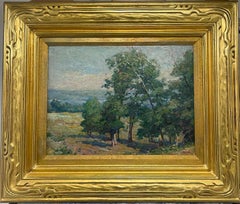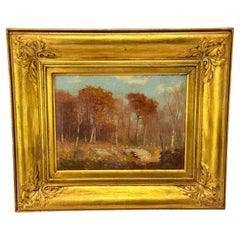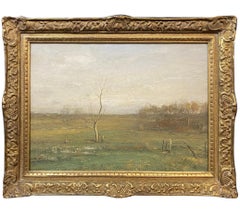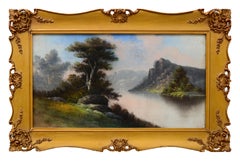Items Similar to Henry Ward Ranger Connecticut Landscape Oil Painting 1858–1916 American Tonalist
Want more images or videos?
Request additional images or videos from the seller
1 of 13
Henry Ward RangerHenry Ward Ranger Connecticut Landscape Oil Painting 1858–1916 American Tonalistcirca 1900
circa 1900
$11,200
$14,00020% Off
£8,498.30
£10,622.8820% Off
€9,717.05
€12,146.3120% Off
CA$15,643.36
CA$19,554.2020% Off
A$17,393.29
A$21,741.6120% Off
CHF 9,081.82
CHF 11,352.2720% Off
MX$211,718.71
MX$264,648.3820% Off
NOK 115,880.03
NOK 144,850.0420% Off
SEK 108,574.05
SEK 135,717.5620% Off
DKK 72,520.12
DKK 90,650.1520% Off
Shipping
Retrieving quote...The 1stDibs Promise:
Authenticity Guarantee,
Money-Back Guarantee,
24-Hour Cancellation
About the Item
Henry Ward Ranger
Connecticut Landscape
oil/panel 12 x 16 image size 21 3/8 x 25 3/8 x 2 3/4 framed
A wonderful example of Rangers painting style of glazes and areas of impasto textures throughout housed in an original frame that shows some wear but shows well. No signs of repair or restoration.
With Rangers style of using glazes, etc., it is very difficult to get exact colors in the photos as digital cameras read thru time but the photos re close and representative of this painting.
The back has cardboard with hand written notes as seen in the photos which I kept even though the actual board underneath, also pictured, has a typed version of the notes on a label.
All of the original hardware is still attached but I added securing clips and new hanger and wires to help with the weight as pictured. Fairly heavy for its size.
Borrowed from Wikipedia
Henry Ward Ranger (January 29, 1858 – November 7, 1916) was an American artist. Born in western New York State, he was a prominent landscape and marine painter, an important Tonalist, and the leader of the Old Lyme Art Colony. Ranger became a National Academician (1906), and a member of the American Water Color Society. Among his paintings are, Top of the Hill, Corcoran Gallery of Art, Washington, D.C.; and East River Idyll, Carnegie Institute, Pittsburgh, Pennsylvania.[1]
Borrowed from Artsy
Henry Ward Ranger
American, 1858–1916
By 1914, Henry Ward Ranger was known as the leader of the “Tonal School” in American art circles. A habitué of the artist colony at Old Lyme, Connecticut, he later moved up the coast to the remote fishing town of Noank where he was inspired by abandoned farms and ancient oaks: the “civilized landscape”, as George Inness described it. Of all the major Tonalists, Ranger maintained a lingering allegiance to Barbizon models of paint handling and the Dutch tradition of landscape painting. But after 1900, he developed a freer and more vigorous personal style that allowed him to explore the American landscape with a new intimacy, employing James Abbott McNeill Whistler’s design principles of cropping and emphasis on subtle patterns. Ranger’s paint surfaces have a mosaic-like quality, glittering darkly—especially when the ground of the canvas or panel is allowed to show through the pigment, a nod to the veils of glazing the artist so admired in Venetian painting.
Borrowed from Questroyal Fine Art
Referred to as “the dean of the American landscape” by the New York Times in 1916, Henry Ward Ranger was one of the country’s most important Tonalists. Born in Syracuse, New York, Ranger developed his soft, atmospheric style after studying art in France and Holland. The young artist was deeply influenced by the moody, tonal landscape paintings of the Barbizon and Dutch Schools and began painting forest interiors in the Tonalist manner. He exhibited extensively at prestigious venues including the National Academy of Design, the Brooklyn Art Association, the Boston Art Club, and the Paris Salon, and won medals at the Paris Exposition of 1900, the Buffalo Pan-American Exposition of 1902, and the American Artist Society’s 1907 show. Yet Ranger was most famous as one of the founders of the Old Lyme art colony in Connecticut, where he began painting in the late 1890s. The colony became “an American version of Barbizon” during the height of the Tonalist movement and maintained a vital artistic presence throughout the twentieth century. Ranger’s paintings are now featured in the collections of the Whitney Museum of American Art, the Metropolitan Museum of Art, the Corcoran Gallery of Art, the National Gallery of Art, the Smithsonian American Art Museum, and the Brooklyn Museum of Art. The Florence Griswold Museum held a Ranger retrospective in 1999, which generated renewed interest in his work.
SELLERS STATEMENT
I have been in the art business as an artist and collector since the early 80's. I'm currently offering select paintings from my collection like this one. In order to collect new paintings, I must sell off some of my current collection.
For art that I have painted, it is derived in a variety of ways. I'm a responder. I respond to light, color, design, etc. and I love painting both outdoors on location and in the studio under a controlled environment. I try to convey an idea, mood or just simply a beautiful setting. I'm inspired by a wide variety of subject matter and styles of painting and do not adhere to just one way.
My paintings have won numerous awards over the years and have been collected both nationally and internationally. They can be found in three museum collections, the White House Collection and many private collections.
- Creator:Henry Ward Ranger (1858 - 1916, American)
- Creation Year:circa 1900
- Dimensions:Height: 21.38 in (54.31 cm)Width: 25.38 in (64.47 cm)Depth: 3 in (7.62 cm)
- Medium:
- Movement & Style:
- Period:
- Condition:
- Gallery Location:Chesterfield, NJ
- Reference Number:1stDibs: LU1254116249252
Henry Ward Ranger
A key person in the establishment of the Old Lyme, Connecticut art colony in 1899, Henry Ward Ranger is regarded as the leader of the Tonalist movement in America and was a leading painter in this country in the late 19th and early 20th-centuries. He was born in Geneseo and raised in Syracuse, New York, and in 1873, enrolled in the College of Fine Arts at Syracuse University, where his father was a professor of photography and drawing. Two years later, he became a re-toucher of paintings in his father's studio and did not earn a college degree. He also spent much time in New York City, where he was a writer of music criticism and visited galleries, where he had his first exposure to French Barbizon painting. During much of the 1880s, he painted watercolors of marine subjects, and exhibited those in New York City, Boston, and Paris. As a student in France, he became greatly interested in the Barbizon School of painters, and then a trip to The Hague, Holland, was even more influential when he met a large colony of Dutch painters called "The Hague School", whose emphasis was on Realism and Tonalism. Their soft, Atmospheric and Tonalist style of sombre colors seemed to suit him. However, his soft colors later became a special problem for anyone trying to restore his paintings as it was difficult to distinguish original color from soil on canvases. He did his sketches "en plein air" but finished his paintings in his studio. In 1885, Ranger moved to New York City and took up easel painting increasingly favoring oils over watercolors. In 1892, he had a one-man exhibition at the Knoedler Galleries in New York City. Many of his works in that show were forest interiors and tree studies. Gradually his palette lightened with color and luminosity suggesting the influence of George Inness. In the summer of 1899, Ranger discovered Florence Griswold's boardinghouse in Old Lyme, Connecticut, and he returned in the summer of 1900. With his influence and the friendship of Florence Griswold, he became the leader of the artists' colony of Old Lyme, "an American version of Barbizon" for three years. However, the prevalent style changed to Impressionism with the 1903 arrival of Childe Hassam. He became disenchanted with painting at Old Lyme with the arrival of Childe Hassam in 1903 and the subsequent influence of his Impressionist style. In protest of the plein-air, fast painting, and lightened palette and abstraction of these Impressionists, Ranger, in 1905, moved farther down the coast to Noank, Connecticut near the Mystic River. Like many of his associates, he also maintained a studio in New York City where he was very prominent and often lectured and wrote about art and took an active part in the art community. He was a member of the National Academy of Design and the National Arts Club, and he wrote articles about art that were published.
About the Seller
4.9
Platinum Seller
Premium sellers with a 4.7+ rating and 24-hour response times
Established in 2019
1stDibs seller since 2019
197 sales on 1stDibs
Typical response time: <1 hour
- ShippingRetrieving quote...Shipping from: Chesterfield, NJ
- Return Policy
Authenticity Guarantee
In the unlikely event there’s an issue with an item’s authenticity, contact us within 1 year for a full refund. DetailsMoney-Back Guarantee
If your item is not as described, is damaged in transit, or does not arrive, contact us within 7 days for a full refund. Details24-Hour Cancellation
You have a 24-hour grace period in which to reconsider your purchase, with no questions asked.Vetted Professional Sellers
Our world-class sellers must adhere to strict standards for service and quality, maintaining the integrity of our listings.Price-Match Guarantee
If you find that a seller listed the same item for a lower price elsewhere, we’ll match it.Trusted Global Delivery
Our best-in-class carrier network provides specialized shipping options worldwide, including custom delivery.More From This Seller
View AllChauncey Foster Ryder Landscape with Figures Oil Painting 1868-1949 Tonalist
By Chauncey Foster Ryder
Located in Chesterfield, NJ
CHAUNCEY FOSTER RYDER (American, 1868-1949),
Pasture Lands
oil/canvas signed LR 31.5 x 39.5 image, 40.5 x 48.5 framed
A wonderfully subtle tonalist painting by Ryder incorporating a farmer/farmhand probably moving cows about the pastures mid right in the scene. Ryder uses a subtle S design from lower left that zig zags up to the figure and cows. The painting shows Ryder's masterful use of abstract design and technique utilizing textures in his application of paint giving the painting life and interest.
Original frame, some craquelure in sky, old surface. Bears Newhouse Galleries, possibly NYC, label verso.
The painting hangs in my collection currently and would benefit from a cleaning and new varnish. It is a large museum quality oil painting.
SHIPPING-This will need In Home Delivery service as it is too large for me to pack. The handling time is listed as 10 days but is dependent on who 1stdibs hires and their schedule to pick up and deliver. 3 -7 weeks is listed in the shipping section for this service. Buyer can also arrange for their own pick up.
Bio-
Chauncey Foster Ryder (29 February 1868 – 18 May 1949)[1] was an early 20th century American Postimpressionist Tonalist landscape painter known for a green-gray palette termed 'Ryder green'.
Education and personal life
Ryder was born in 1868 in Danbury, Connecticut, but grew up mainly in New Haven.[2][3] He began studying painting as a boy. In his early twenties, he moved to Chicago to attend the Art Institute,[4] then Smith's Academy.[5] After only a year at the latter, he was hired as an instructor.[5]
In 1891, he married Mary Dole Keith.[5] In 1901, they moved to Paris, France, where Ryder continued his art education, studying with Jean-Paul Laurens at the Académie Julian. Ryder stayed in France for several years, living in an art colony at Étaples and exhibiting his work at the Paris Salon (1903–1909).[3] He took on occasional students, including American painter William Posey Silva...
Category
20th Century Tonalist Landscape Paintings
Materials
Oil
Emil Carlsen American Impressionist landscape oil Painting Salmagundi Club
By Soren Emil Carlsen
Located in Chesterfield, NJ
Yellow Landscape/Wood Interior/Birch Forest
3 different titles on 3 labels
DESCRIPTION
Yellow Landscape oil /panel
bears Florence G. Carlsen Estate stamp on Brett Mitchell Collecti...
Category
Early 20th Century Tonalist Landscape Paintings
Materials
Oil
American Impressionist Artist Guy C Wiggins 1883-1962 Landscape Oil Painting
By Guy Carleton Wiggins
Located in Chesterfield, NJ
Rocks & Trees
Oil/Board
12 x 16 image unframed, 18.75 x 22.75 framed
Signed lower left although hard to read.
No restoration housed in a reproduction frame.
The painting is in beauti...
Category
21st Century and Contemporary Impressionist Landscape Paintings
Materials
Oil
Impressionist William Chadwick British/American Landscape with Trees Old Lyme Ct
By William Chadwick
Located in Chesterfield, NJ
Landscape with Trees
Oil/Canvas
12 x 16 unframed, 21.5 x 25 framed
Painting is in good condition, signed bottom left margin with craquelure in the clouds as shown. Housed in beautif...
Category
21st Century and Contemporary Impressionist Landscape Paintings
Materials
Oil
Chauncey Foster Ryder Landscape with Figures Oil Painting 1868-1949 Tonalist
By Chauncey Foster Ryder
Located in Chesterfield, NJ
CHAUNCEY FOSTER RYDER (American, 1868-1949), landscape with figures on a bridge, oil on canvas, signed lower left. Framed under glass. Minor craquelure, dirt and grime. Possible label remnant from William Macbeth Gallery attached. Ryder's NYC Gallery/Dealer. See bio below.
Canvas 12-1/4''h, 16''w. unframed and 16 x 20 framed as pictured.
Provenance: Estate of Joseph ''Jay'' St. Mark, PhD, of Newtown, Connecticut, historian, appraiser, and collector of fine Americana.
Bio-
Chauncey Foster Ryder (29 February 1868 – 18 May 1949)[1] was an early 20th century American Postimpressionist Tonalist landscape painter known for a green-gray palette termed 'Ryder green'.
Education and personal life
Ryder was born in 1868 in Danbury, Connecticut, but grew up mainly in New Haven.[2][3] He began studying painting as a boy. In his early twenties, he moved to Chicago to attend the Art Institute,[4] then Smith's Academy.[5] After only a year at the latter, he was hired as an instructor.[5]
In 1891, he married Mary Dole Keith.[5] In 1901, they moved to Paris, France, where Ryder continued his art education, studying with Jean-Paul Laurens at the Académie Julian. Ryder stayed in France for several years, living in an art colony at Étaples and exhibiting his work at the Paris Salon (1903–1909).[3] He took on occasional students, including American painter William Posey Silva...
Category
21st Century and Contemporary Impressionist Landscape Paintings
Materials
Oil
Roy Henry Brown NA American Impressionist Landscape Oil Painting 1879-1956
By Roy Henry Brown
Located in Chesterfield, NJ
A landscape mountain hillside oil painting on panel by artist Roy Henry Brown possible western scene. Painting is under glass signed lower right. The image measures sight size 10 x 1...
Category
Early 20th Century Impressionist Landscape Paintings
Materials
Oil
You May Also Like
Joseph H. Greenwood (MA, 1857-1927) Tonalist New England Landscape
Located in Atlanta, GA
Joseph H. Greenwood (Massachusetts, 1857-1927), "New England Landscape" - Oil on Board, 14.75" w x 12.25" h.
Joseph Greenwood, renowned for his evoc...
Category
Antique 19th Century American Arts and Crafts Paintings
Materials
Giltwood, Paint
Elbridge Kingsley 19th Century Tonalist Landscape
Located in San Francisco, CA
Elbridge Kingsley: 1842-1918. Listed American artist whose paintings are very rare. He was born in Carthage Ohio and moved to Hatfield Massachusetts as an infant. He ended up becoming a successful wood engraver printing a lot of George Inness and Albert Pinkham Ryder...
Category
Late 19th Century Tonalist Landscape Paintings
Materials
Oil
Tonalist Landscape
Located in Milford, NH
A fine tonalist landscape by American artist J. Francis Murphy (1853-1921). Murphy was born in Oswego, New York, he moved to Chicago in 1868, where his father was employed in the shipping industry. In Chicago, Murphy began working as a scene painter in a local theatre and was quickly promoted to lead his co-workers. Largely self-taught, his only training consisted of a few classes at the Chicago Academy of Design. There he became friends with Emil Carlsen and Theodore Robinson, and in 1873, Academy members elected him an Associate; a few weeks later, he became an Academician. His work was first exhibited at the National Academy of Design in 1876, where he was inducted eleven years later.He won numerous prizes, medals and honors for his landscape paintings, which are said to rank with those of George Inness, Alexander Wyant, and Homer Martin. Although his world was a limited one, his landscapes captured the forms of nature and the subtle nuances of the scene. Murphy was referred to as the "American Corot" because of his similarity to the painting style of Camille Corot (1796-1875), one of the original Barbizon...
Category
Early 1900s Tonalist Landscape Paintings
Materials
Canvas, Oil
Early 20th Century Tonalist Pastel Landscape
By William Henry Chandler
Located in Soquel, CA
Early 20th Century Tonalist Pastel Landscape
Beautiful tonal landscape, c.1915, by pastel artist William Henry Chandler (American, 1854-1928). The viewer looks out over a serene riv...
Category
1910s Tonalist Landscape Paintings
Materials
Paper, Pastel
$2,100 Sale Price
30% Off
Accomplished Tonalist Painter William Merritt Post New England Landscape
By William Merritt Post
Located in Rockport, MA
William Merritt Post (1856–1935) was an American tonalist and landscape painter celebrated for his atmospheric depictions of rural New England. Working in a tonal style, Post used mu...
Category
20th Century American Impressionist Landscape Paintings
Materials
Oil
Late 19th Century Tonalist Landscape with Oak Trees
By Willard LeRoy Metcalf
Located in Soquel, CA
Gorgeous late 19th century Tonalist landscape painting of foothills and oak trees in the style of Willard Leroy Metcalf circa 1900. Inscribed "M" in circle monogram lower left corner and on frame verso. Presented in original rustic giltwood frame. Image size: 6"H x 8"W. Framed size: 8.5"H x 10.5"W.
Tonalist are usually intimate works, painted with a limited palette. Tonalist paintings are softly expressive, suggestive rather than detailed, often depicting the landscape at twilight or evening, when there is an absence of contrast. Tonalist paintings could also be figurative, but in them, the figure was usually out of doors or in an interior in a low-key setting with little detail.
Tonalism had its origins in the works of the French Barbizon school and in the works of American painters who were influenced by them. California Tonalism was born when the emphasis in California landscape painting passed from the grand landscapes of works like those of Thomas Hill and William Keith's early career, to more intimate views of a domesticated landscape. At the same time, the parallel Pictorialist Photography...
Category
1890s Tonalist Landscape Paintings
Materials
Oil, Cardboard
More Ways To Browse
James Holland
George Read Art
Vintage Cardboard Collectibles
Abbott Vintage
James Dean Vintage
1900 Camera
Oil Painting Of Pennsylvania Dutch
Henry Dean
1906 Picture Frames
Dark Moody Oil Landscape Painting
Vintage Fishing Collectibles
Restoration Hardware French
Collectible Vintage Oil Cans
Vintage Heavy Hangers
Restoration Hardware Art
Peter Arnold
Longhorn Art
M Cohen
